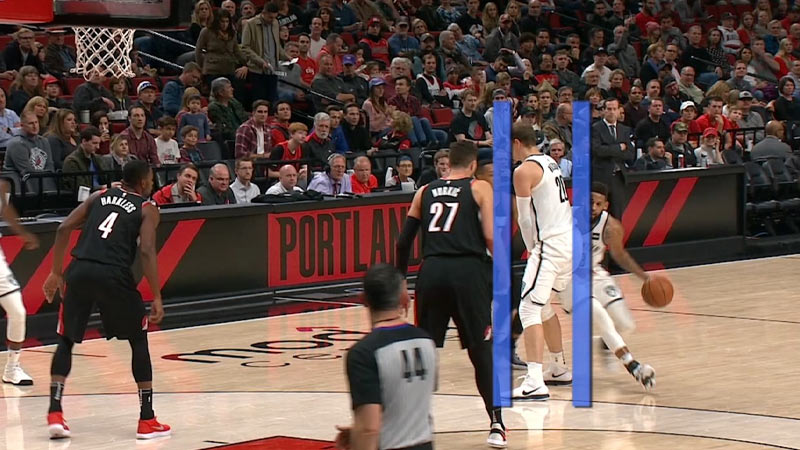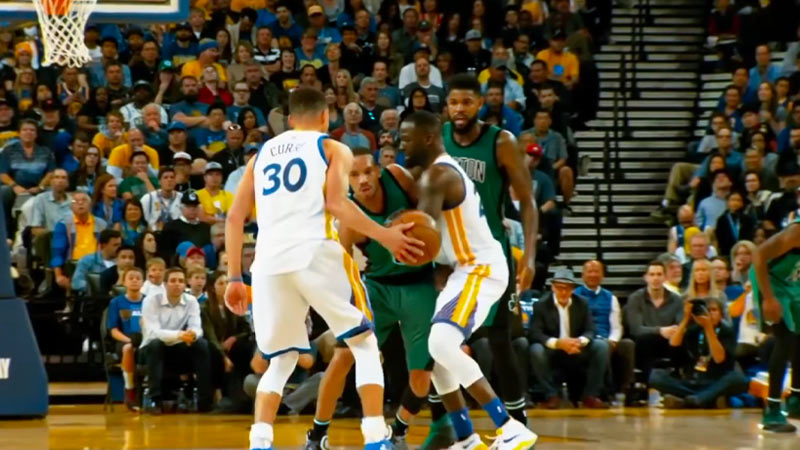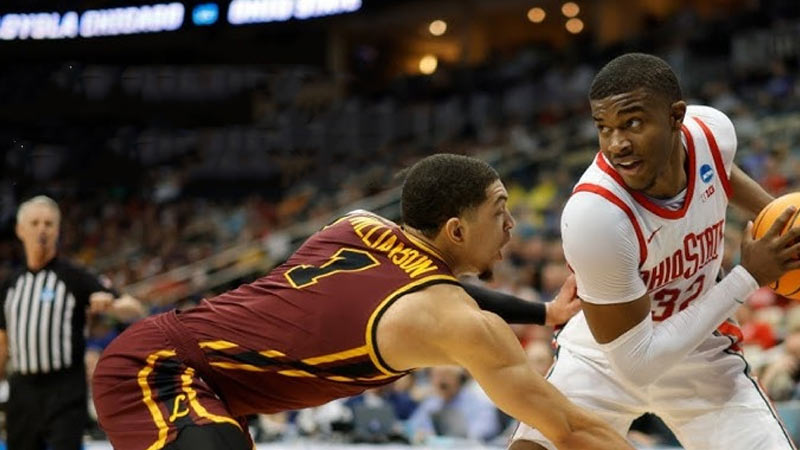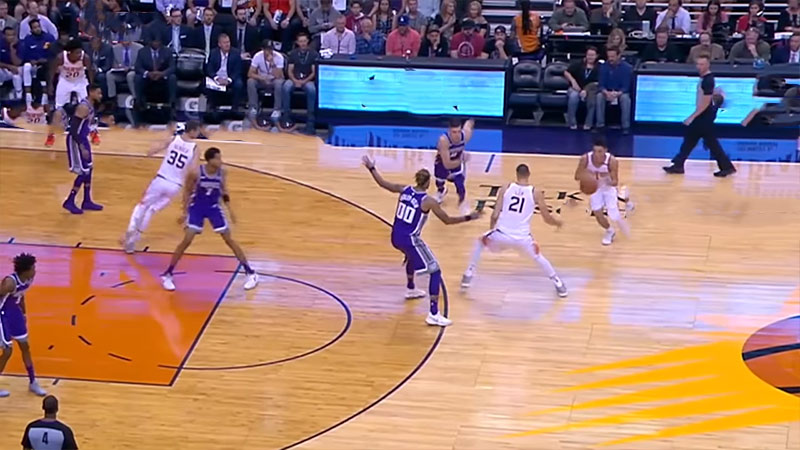Basketball, known for its fast-paced action and strategic gameplay, has captivated millions of fans worldwide. From skillful dribbling to precise shooting, numerous elements make this sport exciting.
One fundamental concept that often goes unnoticed but plays a crucial role in the game is the screen. In basketball, players use screens as a strategic maneuver to create space, open up opportunities, and confuse the defense.
However, not all screens are legal according to the rules of basketball. What is a moving screen in basketball, and why is it considered a foul?
Understanding the concept of screens is essential for players and fans alike, as it adds depth to the game and allows for a deeper appreciation of the intricacies involved.
In this article, we will delve into the specific type of screen known as the moving screen, exploring its definition, rules, offensive and defensive aspects, violations, consequences, and significance in basketball. By the end, you will gain a comprehensive understanding of the moving screen and its impact on the game.
What Is A Moving Screen In Basketball?
A moving screen in basketball is an illegal, offensive tactic where an offensive player sets a screen for a teammate while moving. The screen impedes the defender’s movement and creates space for the ball handler or a teammate.
However, suppose the offensive player does not establish a stationary position before contacting the defender. In that case, it results in a moving screen violation.
Purpose Of A Screen
Screens are a crucial part of basketball strategy, allowing offensive players to create open lanes, confuse defenders, and facilitate scoring opportunities.
Setting A Legal Screen
To develop a legal screen, an offensive player must establish a stationary position before contacting the defender. They must allow the defender to react and maneuver around the net.
Moving Screen Violation
A moving screen violation occurs if an offensive player fails to establish a stationary position. This infraction leads to a turnover, and the offensive team loses possession of the ball.
Offense’s Responsibility
The offensive player setting the screen ensures it is legal. They must be mindful of their footwork and avoid moving laterally or toward the defender while setting the screen.
Defender’s Reaction
When faced with a moving screen, defenders can try to navigate, fight through, or communicate with teammates to switch defensive assignments.
Officials’ Role
The game officials are responsible for detecting a moving screen. They observe the positioning and movement of the offensive player setting the screen to determine if it is legal or illegal.
Exploring The Moving Screen

Understanding the concept of a moving screen is crucial in basketball. This section will delve into the definition and explanation of a moving screen, highlight the differences between moving and stationary screens, and outline the rules and regulations regarding cruising screens in the game.
Definition And Explanation Of A Moving Screen
A moving screen in basketball refers to an offensive player’s illegal tactic of setting a screen for a teammate while in motion. The purpose of the screen is to impede the defender’s movement, creating an advantage for the ball handler or another offensive player.
However, for the screen to be legal, the offensive player must establish a stationary position before contacting the defender.
How A Moving Screen Differs From A Stationary Screen
A critical distinction between a moving screen and a stationary screen lies in the positioning of the offensive player. In a standing screen, the offensive player sets their feet and remains fixed while making contact with the defender.
This allows the defender an opportunity to react and navigate around the screen. In contrast, a moving screen occurs when the offensive player is still moving or shifts their position while attempting to set the screen, depriving the defender of a fair chance to react.
Rules And Regulations Regarding Moving Screens In Basketball
Legal Screens
To set a legal screen, an offensive player must establish a stationary position before contacting the defender. The player cannot move laterally or toward the defender while setting the screen.
Moving Screen Violation
If an offensive player fails to set a legal screen by moving or shifting their position while contacting the defender, a moving screen violation results. This infraction leads to a turnover, with the opposing team gaining possession of the ball.
Offensive Responsibility
The offensive player responsible for setting the screen must be mindful of their footwork and ensure they do not move while making contact with the defender. They should establish a stationary position to allow the defender an opportunity to react.
Officials’ Role
Detecting a moving screen is the responsibility of the game officials. They observe the positioning and movement of the offensive player setting the screen to determine if it complies with the rules.
Offensive Aspects Of A Moving Screen

In basketball, the offensive team utilizes moving screens strategically to gain an advantage over the defense. This section focuses on the screener’s role, the benefits of using a moving screen, and strategies for setting an effective screen.
Role Of The Screener In An Offensive Play
The screener plays a crucial role in offensive plays involving a moving screen. Their primary objective is to create separation for the ball handler or a teammate by impeding the defender’s movement. The screener must position themselves correctly and time their movement to maximize the effectiveness of the screen.
Benefits Of Using A Moving Screen For The Offense
Using a moving screen offers several advantages to the offensive team. It can create open passing lanes, disrupt defensive rotations, and force switches, leading to mismatches.
By setting a moving screen, offensive players can generate opportunities for jump shots, drives to the basket, or open looks for teammates. It also helps in breaking down the defense and creating scoring chances.
Strategies And Techniques For Setting An Effective Moving Screen
Offensive players must employ various strategies and techniques to set an effective moving screen. These include proper footwork, timing, and communication with teammates.
Establishing a stationary position before contacting the defender is essential to avoid a moving screen violation. The screener should anticipate the defender’s movement and adjust their angle and positioning accordingly.
They can also utilize fakes or sudden changes in direction to catch the defender off guard.
Defensive Techniques Against A Moving Screen

Defending against moving screens is crucial in basketball to maintain defensive integrity and prevent the offense from gaining an advantage.
This section will explore the importance of guarding against moving screens, defensive strategies to counter them, and the role of communication and teamwork in this aspect of the game.
Importance Of Defending Against Moving Screens
Defending against moving screens is vital because it allows defenders to maintain their defensive position, impede the offensive player’s progress, and prevent accessible scoring opportunities.
By effectively countering moving screens, defenders can disrupt offensive plays, maintain defensive spacing, and protect their teammates from being caught off-guard.
Defensive Strategies To Counter Moving Screens
Anticipation and Preparation: Defenders must anticipate screens and mentally prepare to react quickly. By studying opponents’ tendencies, defenders can predict when and where screens will likely occur, allowing them to position themselves accordingly.
Communication
Effective communication among defenders is vital to combating moving screens. By communicating with teammates, defenders can alert each other about screens, coordinate switches, and provide support in navigating around screens.
Footwork And Agility
Defenders need to employ quick footwork and agility to navigate around screens. Defenders can effectively maneuver through screens and maintain defensive positioning by staying low, using lateral movements, and being proactive in reading offensive players’ actions.
Communication And Teamwork In Defending Against Moving Screens
Switching And Hedging
Switching involves defenders exchanging defensive assignments to counterscreens. At the same time, hedging refers to a temporary double-team on the ball handler before returning to their original position. Proper communication and coordination between defenders are essential to execute these strategies successfully.
Help Defense
When defenders get caught on a moving screen, teammates must provide support through help defense. By stepping up to impede the offensive player’s progress or communicating switches, defenders can disrupt offensive plays and buy time for their teammates to recover.
Recovery And Reestablishment
If a moving screen temporarily obstructs a defender, they must quickly recover and reestablish their defensive position. This requires agility, awareness, and communication to avoid leaving offensive players unguarded.
Frequently Asked Questions
Who sets the best screens in the NBA?
Who sets the best screens in the NBA?
What is a RAM screen in basketball?
The ram screen is a basketball offensive action that occurs when one player will set an off-ball screen for a second player and afterwards, the second player will begin to set an on-ball screen for a third player, currently in possession of the basketball.
When can you move after setting a screen?
Once you have established your position, do not move your feet or lean your shoulder into the screened opponent or you will get called for a “moving/illegal screen” (an offensive foul). You must be stationary and not move with the defender, and you can’t push the defender away.
Can you set a screen out of bounds in basketball?
No, it is not legal to set a screen out of bounds in basketball.
Can you set a screen in the paint in basketball?
You can set a stationary screen in the paint on the basketball, provided that it is used for a legitimate purpose and you are not blocking or assaulting anyone else. You should also be aware of the “legal screens” rule which states that you cannot block someone’s shot while they are shooting, nor should you try to make them shoot over your screen.
To Recap
Moving screens play a significant role in basketball, both offensively and defensively. They are offensive tactics to create space for the ball handler or a teammate. Still, when executed improperly, they result in violations and turnovers.
Defensively, countering moving screens requires anticipation, communication, and agile footwork to maintain defensive positioning. Moving screens impact the game’s flow, requiring players to adapt and strategize.
Overall, understanding and effectively addressing moving screens are crucial for teams to maintain fair play and defensive integrity and create scoring opportunities.
By upholding the rules and employing proper defensive techniques, teams can navigate the challenges posed by moving screens and enhance their chances of success on the basketball court.







